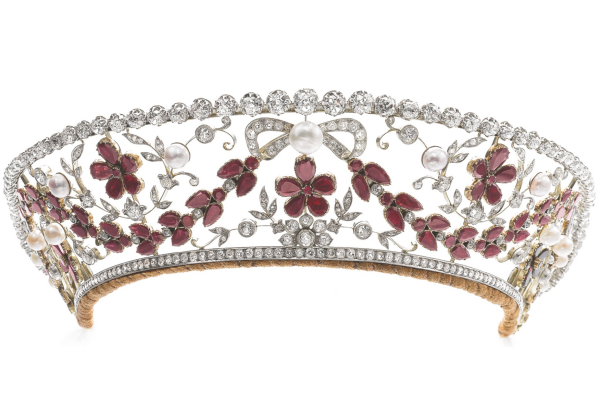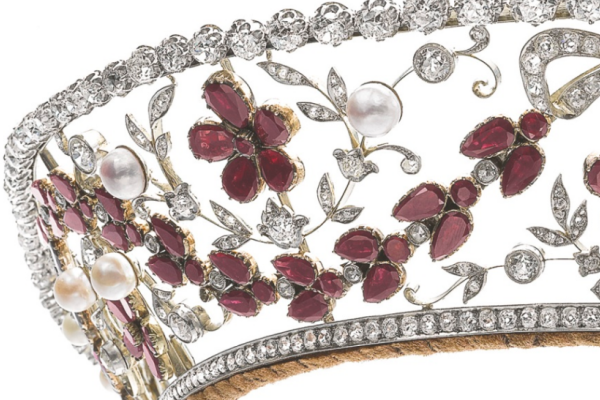 |
| Sotheby’s |
January babies are lucky to have the luscious garnet as their birthstone — a deep scarlet gem with an intriguing, ruby-like sparkle. Today’s tiara, the Rosenborg Kokoshnik, is a rare royal tiara set with the stone.
 |
| Sotheby’s |
The tiara was made by a Danish court jeweler, Aage Dragsted, in the 1930s. The piece was commissioned by Prince Viggo of Denmark, the fourth son of Prince Valdemar of Denmark and his French-born wife, Princess Marie of Orleans. King Christian X of Denmark was Viggo’s first cousin.
 |
| Eleanor Margaret Green and Prince Viggo of Denmark on their wedding day, 1924 |
Two of Viggo’s siblings, Prince Axel and Princess Margrethe, married fellow royals (Princess Margaretha of Sweden and Prince Rene of Bourbon-Parma, respectively). Another brother, Prince Aage, married an Italian aristocrat, Mathilde Calvi di Bergolo. But both Prince Viggo and his third brother, Prince Erik, looked across the ocean to find wealthy wives. Erik married a Canadian heiress, Lois Booth, in February 1924. And only a few months later, Viggo wed Eleanor Margaret Green, the daughter of a wealthy New York family. Eleanor could claim impressive ancestors on both sides of her lineage; she was a granddaughter of Abram S. Hewitt, the mayor of New York City who was instrumental in starting the city’s subway system, and a great-granddaughter of Peter Cooper, who designed the very first steam locomotive. The family’s best-known legacies today are the Cooper Union, a private college in Manhattan, and the Cooper Hewitt Smithsonian Design Museum, founded by Eleanor’s mother and aunt.
As was customary at the time, Prince Viggo renounced his place in the Danish line of succession when he married a commoner, becoming His Highness Prince Viggo, Count of Rosenborg. Eleanor’s new title, accordingly, was Her Highness Princess Viggo. Prince and Princess Viggo remained close members of the Danish royal family after their marriage, settling in Copenhagen and involving themselves in charitable work. They also attended most of the grand royal functions of their era.
 |
| Sotheby’s |
Being a part of a royal family in the ’20s and ’30s meant lots and lots of tiara events, so it shouldn’t come as a surprise that Princess Viggo (who brought a lot of capital with her to her marriage) owned several sparklers of her own. One of them was this unusual garnet, pearl, and diamond tiara. The piece’s kokoshnik shape, delineated by a row of diamonds at the top and base of the tiara, was inspired by headwear popular in Russia. The top line of diamonds is detachable and could be worn separately as a riviere.
 |
| Sotheby’s |
The tiara features ribbons, swags, and floral elements in its design. A large natural saltwater pearl sits in the center of its main bow element.
 |
| Sotheby’s |
The garnet flowers in the tiara provide a lovely contrast with the diamond-set floral blossoms and leaves that are festooned across the kokoshnik.
 |
| Princess Viggo (standing behind King Christian X of Denmark) wears the tiara in Stockholm during the celebrations of the wedding of Crown Prince Frederik of Denmark and Princess Ingrid of Sweden, 1935 (Kungahuset) |
Princess Viggo appeared in the tiara at several prominent royal gatherings during her lifetime. In 1935, she took the tiara with her to Stockholm, where she attended the wedding festivities of Princess Ingrid of Sweden and Crown Prince Frederik of Denmark. In the astonishing group portrait above, Princess Viggo is on the left side of the photo, standing behind King Christian X and Queen Astrid of Belgium and directly in front of Crown Princess Martha of Norway. She’s wearing the garnet kokoshnik for the occasion.
Prince and Princess Viggo did not have any children of their own. Following their deaths (Eleanor in 1966, Viggo in 1970), the kokoshnik was inherited by Viggo’s sister-in-law, Princess Margaretha. She died in 1977, and the tiara subsequently passed to Axel and Margaretha’s son, Count Flemming of Rosenborg. His wife, Countess Ruth, wore the kokoshnik often at royal events near the end of her long life. In 2007, she chose the tiara for the 70th birthday celebrations of King Harald V of Norway in Oslo. She’s pictured above wearing the kokoshnik for a banquet during the celebrations; you’ll note that she was escorted in to dinner by Sir Timothy Laurence, husband of the Princess Royal.
 |
| Sotheby’s |
After Countess Ruth’s death in 2010, her descendants decided to auction the kokoshnik. After a failed sale at Bukowski’s, the family turned to Sotheby’s in Geneva. In May 2014, the tiara was sold in Switzerland for more than $275,000 USD, more than doubling its auction estimate.
Leave a Reply